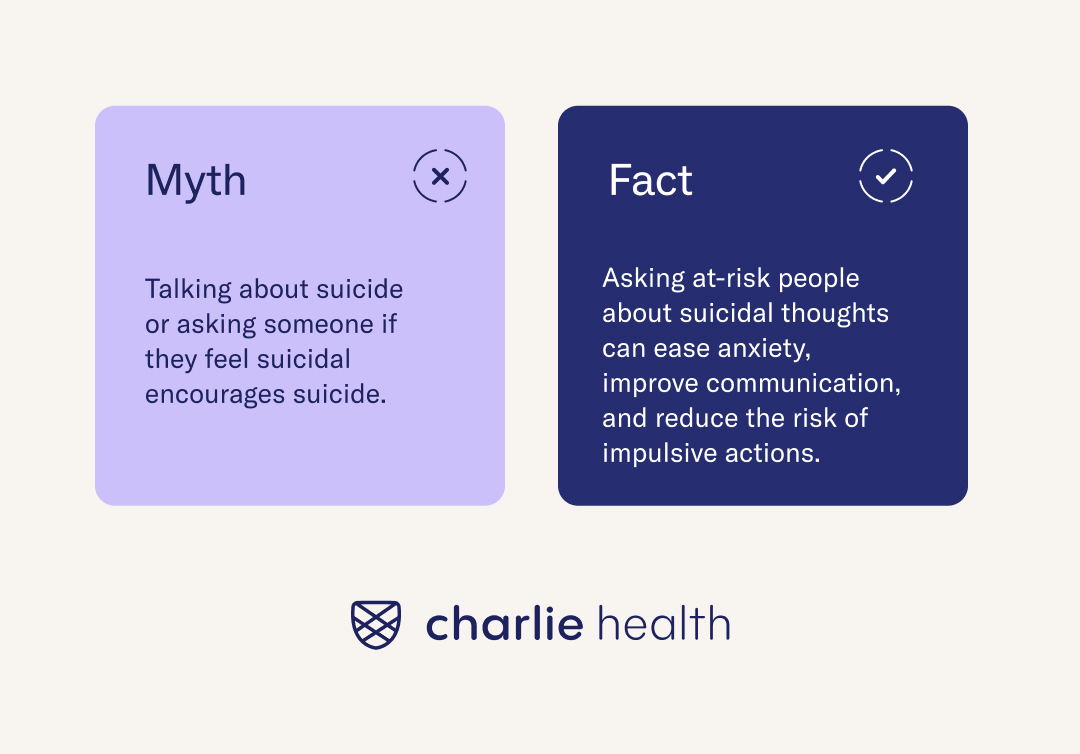
Table of Contents
Suicide Prevention: How You Can Help
Written By: Charlie Health Editorial Team
March 10, 2022
9 min.
Learn more about suicide prevention, including how to identify warning signs, assess risk factors, and find the right level of care for yourself or someone you know.
Learn more about our Clinical Review Process
Table of Contents
WARNING: This post contains in-depth language and information about suicide. If you are in acute crisis looking for help, please call or text the National Suicide Prevention Lifeline at 988 or dial 911.
Suicide can affect anyone regardless of age group, income status, education level, sexual orientation, race, or ethnicity. It’s also on the rise in the United States, particularly among young people. Every 90 minutes, a young person commits suicide. As the second leading cause of death for young people aged 10–34, youth suicide must be seen as a public health epidemic. Suicide, however, is completely preventable. This prevention begins with having honest conversations about suicidal ideation (otherwise known as suicidal thoughts or thinking).
Despite the pervasive stigma, suicidal ideation is not a sign of weakness. Instead, suicidal ideation is a common human response to stressful situations, emotional pain, trauma, and many other challenges.
We can all prevent suicide by better understanding the risk factors, recognizing the warning signs, and knowing how to help at-risk individuals.
What is suicide prevention?
Most people associate suicide prevention with calling a crisis hotline or going to the emergency room. Suicide prevention, however, encompasses a range of preventative factors, including:
- Providing food security, affordable health care, and accessible mental health services
- Developing affordable housing and housing stabilization policies to combat the trauma, hopelessness, and dangers of eviction and homelessness
- Offering free and accessible mental health training to help individuals identify the warning signs of suicide risk
- Educating yourself on the realities of suicide and helping to fight the stigma surrounding mental health disorders by encouraging more people to seek professional help
- Establishing mental health education programs in schools
- Leveraging community engagement to offer resources for individuals at risk
- Accepting family members who identify as LGBTQIA+, as LGBTQIA+ youth are more likely to attempt suicide than their non-LGBTQIA+ peers.
In 2019, over 47,000 people died by suicide in the U.S., and the national suicide rate has increased every year since 2006. According to the CDC, one in five people who died by suicide had expressed their suicidal intent. By listening to those experiencing suicidal ideation, acknowledging their feelings, and offering support and resources, we can take steps to lower suicide rates and help our loved ones build resilience.
Join the Charlie Health Library
Get mental health updates, research, insights, and resources directly to your inbox.
You can unsubscribe anytime.
Understanding the risk factors for suicide
According to the American Psychiatric Association, certain events and life circumstances may increase an individual's risk for suicide. The most common risk factors for suicide include:
- History of suicide attempts
- Family history of suicide
- Substance use issues
- Mood disorders, such as depression and bipolar disorder
- Access to lethal means (i.e., unlocked firearms in the home or easy-to-access prescription medications)
- Traumatic loss and other stressful events (i.e., financial difficulties, bullying, family divorce)
- History of trauma or abuse
- Chronic physical illness, including chronic pain
- Exposure to the suicidal behavior of others
Sometimes, recent stressors or life changes can create intense emotions, and this emotional pain can become a "tipping point" toward suicide.
Although mental health conditions may be a contributing factor to suicide attempts, "many factors contribute to suicide among those with and without known mental health conditions," according to the CDC.
Simply put, someone who’s living with a mental health disorder will not necessarily experience suicidal ideation. At the same time, someone who’s struggling with suicidal ideation doesn’t necessarily have other underlying mental health issues. It’s important to treat each person as a whole person and respect their individual needs.
Do you need more support with
your mental health?
Charlie Health can help.
How to support someone at risk of suicide
If your loved one is experiencing thoughts of suicide, you're probably wondering how to take the first step. According to a 2020 survey, most people understand that suicide is preventable, and they would help someone they know who is at risk. At the same time, many of us are afraid to do or say the wrong thing.
Contrary to popular belief, you don't have to be a mental health professional to help someone at risk. We can all prevent suicide, and the most important thing is to trust your instinct. Whether you're worried about a coworker, family member, or close friend, here's how to take the first step.

Recognize the warning signs of suicide risk
According to the American Foundation for Suicide Prevention, people who commit suicide often show a combination of mood and behavior changes. For example, you might notice a close friend stop showing up to after-school meetings, or they might struggle to turn in homework and study for exams. If a family member is usually laid back, you might notice them acting frustrated or angry on a regular basis.
Some common warning signs of a suicide crisis include:
- Increased use of substances, such as drugs or alcohol
- Internet search history for ways to complete suicide
- Withdrawing from friends, family members, and social activities more than usual
- Changes in sleeping habits, such as sleeping too much or too little
- Expressing increased feelings of fatigue, aggression, or irritability
- Heightened feelings of shame, guilt, or humiliation
- Giving away their possessions or calling people to say goodbye
- Experiencing a sense of relief or sudden improvement in their mood
It's not enough to just pay attention to someone's actions, though. You also need to listen to their words. Someone at risk of a suicide attempt might talk about wanting to sleep forever, being a burden to others, or feeling hopeless.
Remember: warning signs are different for everyone. Sometimes, mental health challenges for one person can start with difficulty sleeping, while another person might feel easily rejected and insecure. Difficult situations can contribute to emotional distress, and even seemingly small things can increase someone's risk.
Ask how they're doing

If you think someone might be having suicidal thoughts, reach out and ask how they're feeling. Even though reaching out might seem like a small thing, survivors of suicide attempts say that connection and attention can go a long way. Suicidal thoughts are inherently isolating, but it can still be very difficult to reach out when you feel alone. Many people dealing with suicidal ideation report that asking for help feels like placing a burden on their loved ones. Reassure them that this isn't true.
You might feel uncomfortable talking about suicide—and that's completely normal. Even if you don't know what to say, offering emotional support can help reduce your loved one's sense of loneliness and isolation. Asking questions like, "How are you feeling?" and saying things like, "If you need to talk to someone, I'm here to listen," are simple gestures that can have a major impact.
Don't be afraid to be direct. While many people are hesitant to talk about suicide for fear of making the situation worse or more triggering, there's no research to support that talking about suicide increases suicidal ideation. In fact, many people who have thoughts of suicide feel a sense of relief when someone asks how they're feeling, and studies suggest that acknowledging suicide can reduce the risk of suicide.
Assess their risk of suicide
Your loved one has told you that they've been thinking about suicide. What's the next step?
Instead of panicking, take the time to assess their risk. People often believe that suicidal ideation requires a hospital visit, but not everyone who expresses suicidal thoughts needs to visit a local crisis center or emergency room. Studies show that most people who've experienced thoughts of suicide haven't had serious thoughts that would lead to a suicide attempt. In other words, more people experience suicidal thoughts than attempt suicide.
To know if your loved one is at risk of a suicide attempt, have a direct conversation. Ask them how serious their thoughts are and whether they have urges to take action. To assess your loved one's risk, you can use the Columbia Protocol, a risk-assessment tool based on a research-based suicide severity rating scale. It contains six questions, ranging from whether your loved one has experienced thoughts of suicide to whether they've worked out the details of their plan.
Someone with a plan has a high risk of taking action. According to the Suicide Prevention Resource Center, approximately 38 percent of people who create a plan move forward with a suicide attempt.
Remain present
If your loved one is at immediate risk, ask them to hold off for a few days. Instead of becoming angry or frustrated with your loved one, empathize with their feelings, show your compassion, and ask them gently to take a step back.
The intense emotions surrounding a suicidal crisis can lead to impulsive actions. In most cases, intense emotions will become more manageable within 24-48 hours. If possible, stay with them until they start feeling better, or offer to be present virtually via phone or video call. If this isn't possible, help them find immediate support or professional help. Try your best to avoid leaving your loved one alone during times of crisis.
Ask your loved one whether they have any lethal means around, and work with them to remove any dangers from their environment, such as unlocked or loaded firearms or prescriptions for things like pain management. According to research from Harvard Health, when lethal means are made less available, suicide rates are reduced.
If your loved one is in imminent danger, check out the National Suicide Prevention Lifeline's five action steps. In addition, the following suicide prevention resources are available:
- The National Suicide Prevention Lifeline (988)
- The Crisis Text Line (text HOME to 741741)
- The National Alliance on Mental Illness HelpLine (1-800-950-NAMI (6264))
- SAMHSA’s National Helpline (1-800-662-HELP (4357))
- Your local emergency department or crisis center
Listen to them without judgment
Even if your loved one isn't at immediate risk, you should still listen and offer emotional support. According to the Suicide Prevention Resource Center, individuals at risk are less likely to feel depressed, suicidal, and overwhelmed after talking to someone who simply listens without judgment.
The most important thing is to keep an open mind and avoid judging your loved one. Don't tell them what to do, interrogate them, or shame them for their feelings. Instead, acknowledge their feelings, offer your compassion, and be an active listener. You might say something like, "I can't imagine how painful this is for you, but I want to be there for you."
Ask them what and who they believe will be the most effective sources of help, and help them create a safety plan. Safety plans are an important part of suicide prevention, and they can help reduce suicide risk. They help individuals cope and seek help during a suicidal crisis. In most cases, a suicidal individual can create a safety plan with their mental health provider, but if they’re not currently seeing professional mental healthcare, a trusted friend or family member can also help.
Make sure to follow through, but don't commit to anything you're not able to accomplish. If you can't physically meet with someone who has thoughts of suicide, help them develop some ideas of people who might be able to help.
Explore suicide prevention tools and resources
During a mental health crisis, navigating mental health resources can feel overwhelming. To help your loved one in future crises, offer to help them find a mental health professional. Even though mental health services might seem intimidating, working with a trained professional is key to developing healthy ways to manage suicidal thoughts.
Research shows that dialectical behavior therapy (DBT) skills, a form of psychotherapy, is an effective treatment for reducing suicide risk. It helps people develop skills and strategies to calm their minds, distract themselves, and overcome suicidal thoughts. Psychotherapy can also treat any co-occurring mental health challenges your loved one is experiencing, including mood disorders, low self-esteem, or substance use issues.
It might be hard for your loved one to keep a mental health appointment or stick with a treatment plan, but friends and family members can help them stay accountable by checking in before and after sessions. In addition, virtual mental health programs can help suicidal individuals access high-quality care from the comfort of their own homes, on their own schedule, and with people who have had similar life experiences.
Contact us
Seeking professional help can feel overwhelming, but finding the right therapist is key to beginning your healing journey.
At Charlie Health, we offer comprehensive mental health care for adolescents, young adults, and families experiencing mental health crises. Our virtual Intensive Outpatient Program consists of groups, individual therapy, and family therapy. We customize treatment plans based on each client's lived experiences, demographic information, and mental health needs.
No matter where you are in your mental health journey, we're here to help you every step of the way. Our team of compassionate, experienced mental health professionals will help you navigate your mental health and learn healthy ways to cope with difficult emotions. Get started today.





